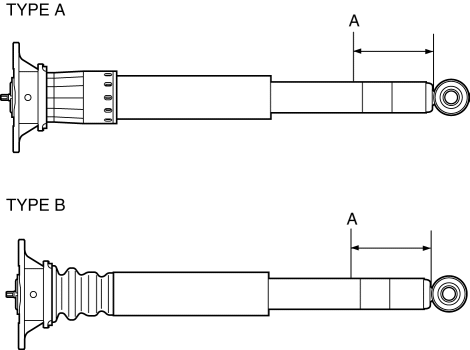Mazda CX-5 Service & Repair Manual: Rear Shock Absorber Disposal
WARNING:
-
Whenever drilling into a rear shock absorber, wear protective eye wear. The gas in the rear shock absorber is pressurized, and could spray metal chips into the eyes and face when drilling.
1. Clamp a rear shock absorber on a flat surface or with the piston pointing downwards.
2. Drill a 2—3 mm {0.08—0.11 in}
hole at point A from the bottom of the tube, so the gas can escape.

-
Point A: 40—50 mm {1.6—1.8 in}
3. Turn the hole downwards.
4. The oil can be collected by moving the piston rod several times up and down and cutting off the end of the tube with a hack-saw.
5. Dispose of waste oil according to the waste disposal law.
 Rear Lower Arm Removal/Installation
Rear Lower Arm Removal/Installation
WARNING:
Be careful not to allow the coil spring to fly off when removing/installing
the coil spring. Otherwise, the coil spring could fly off and cause serious
injury or death, or dam ...
 Rear Shock Absorber Inspection
Rear Shock Absorber Inspection
1. Remove the rear shock absorber..
2. Inspect for damage and oil leakage.
3. Compress and extend the shock piston at least three times. Verify that the
operational force does not change and tha ...
Other materials:
Replace Electrical Battery
If the buttons on the transmitter are inoperable and the operation indicator
light does not flash, the battery may be dead.
Replace with a new battery before the transmitter becomes unusable.
CAUTION
● Make sure the battery is installed correctly.
Battery leakage could occur if it is no ...
Warning/Indicator Lights
Warning (Display Indication)
Message information such as system operations or malfunctions is indicated in
the display. Check the vehicle condition or have the vehicle inspected at an Authorized
Mazda Dealer according to the indication.
Brake System Warning Light
This warning has th ...
Push-Starting
Do not push-start your Mazda.
WARNING
Never tow a vehicle to start it:
Towing a vehicle to start it is dangerous. The vehicle being towed could surge
forward when its engine starts, causing the two vehicles to collide. The occupants
could be injured.
CAUTION
Do not push-start a vehicle that ...
